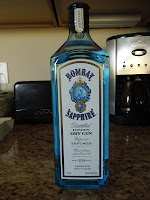
I have just finished two new vessels that I would like to tell you about and show several photos. The reason I'm presenting these two together is they are identical twins except for size. The empty containers are blue gin bottles, Bombay Blue Sapphire, one large and one smaller.
Before we get into my construction techniques, I will explain why the word sage is included in the post title. Sage brush wood is the main decorative wood used in these art pieces. I was fascinated by the shapes exposed when a cross-cut was made in this wood. The color and grain pattern are very pleasant. I collected this wood while living in Wenatchee, Washington. This was in 1979 when I had just married JoAnn. We built in the foothills above the city. It was a fun time and we loved our home that we had designed. Here is a quick peek at Apatchablue, the name we gave our home. The vacant property next door had sage brush growing over it as seen in this winter photo. Due to a job change we began living in a Spokane apartment five days a week and spending weekends in our Apatchablue in Wenatchee. One summer weekend we returned to Apatchablue to find the adjacent property had burned, and just sage stumps remained on the blackened hillside. We found that our neighbors had kept the fire from jumping to our home. I gathered the sage stumps for future art work and these e-P vessels are the first opportunity I have taken to use the wood. As I worked the wood it gave off a strong smoke odor and some of the segments in the vessels have slight scorched edges still vi sable. After all those years these factors are a strong reminder of how lucky we were to have good neighbors.
I decided to encase the blue bottles in wood, fashioned with a pointed top and extended access to the opening of the container. The entire surfaces of these boxed bottles was fiber glassed and then the wood pieces were attaches. Mahogany strips were used to outline and divide space on the flat surfaces. The same strips were used to cover the pointed sections. As in other vessels, the resin grout was worked in all spaces between the wood segments and strips. An orbital sander was used to work all flat sides into smooth surfaces. A drum sander on a hand drill shaped the tapered round tops. Voids in the grout were filled at this point and more sanding leveled out the surface. After this rough sanding, plenty of time was taken to work the surfaces down to a fine finish. Much of this was done by hand with successive finer grades of paper until 400 grade finished the piece, ready for rubbed oil and wax coats.
You will notice I turned mahogany stoppers for each vessel. I have an old wood lathe that I purchased as surplus property from the high school where I was teaching early in my career. It has worked fine for me the many past years. I have several other vessels under construction that require lathe work.
This pair of vessels measure 20" and 26" in height. Their base dimensions are 4" and 5" square respectively. In closing I wish to mention that this big/little twin option will be used on several other vessel designs, when I find appropriate empty vessels. It is a unique way to produce sets that may attract buyers. They could be priced separately or per pair. These were fun to make and I plan to devise another project that uses sage segments. If there are questions you have relative to this post. please contact me; also I would appreciate knowing if you have done similar work. I enjoy sharing. Ed



No comments:
Post a Comment